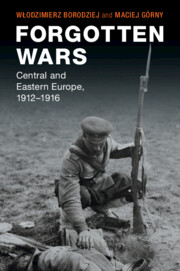Book contents
- Forgotten Wars
- Studies in the Social and Cultural History of Modern Warfare
- Forgotten Wars
- Copyright page
- Contents
- Figures
- Maps
- Capsules
- Additional material
- Introduction
- Part I The Fronts
- 1 The Road to War
- 2 Prelude: The Balkans 1912–1913
- 3 Before the Leaves Fall from the Trees …
- 4 Breakthrough
- Part II The Rear
- Part III Occupation
- Afterword
- Select Bibliography
- Index
3 - Before the Leaves Fall from the Trees …
from Part I - The Fronts
Published online by Cambridge University Press: 15 March 2021
- Forgotten Wars
- Studies in the Social and Cultural History of Modern Warfare
- Forgotten Wars
- Copyright page
- Contents
- Figures
- Maps
- Capsules
- Additional material
- Introduction
- Part I The Fronts
- 1 The Road to War
- 2 Prelude: The Balkans 1912–1913
- 3 Before the Leaves Fall from the Trees …
- 4 Breakthrough
- Part II The Rear
- Part III Occupation
- Afterword
- Select Bibliography
- Index
Summary
In the summer of 1914 the armies that went to war in the East were formed according to similar rules and used similar tactics; all were based on conscription and all boasted vast numbers of men. It was believed that the biggest reservoir of human beings offered the best chance of victory. In this respect the statistics were unequivocal: no state could rival Russia. Moreover, even on a peace footing, the Russian army was three times the size of the German army and ten times that of the Austro-Hungarian army. One could attempt to redress this imbalance through training and equipment, and indeed that is what the Central Powers started to do on a large scale, once war had begun. In July 1914 all sides in the conflict – Russia, Germany, Austria-Hungary, and Serbia – had comparable ordnance which did not differ much from the arsenals tested recently on the battlefields of Thrace and Macedonia.
- Type
- Chapter
- Information
- Forgotten WarsCentral and Eastern Europe, 1912–1916, pp. 61 - 137Publisher: Cambridge University PressPrint publication year: 2021

